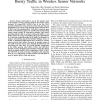Free Online Productivity Tools
i2Speak
i2Symbol
i2OCR
iTex2Img
iWeb2Print
iWeb2Shot
i2Type
iPdf2Split
iPdf2Merge
i2Bopomofo
i2Arabic
i2Style
i2Image
i2PDF
iLatex2Rtf
Sci2ools
GLOBECOM
2010
IEEE
2010
IEEE
ATMA: Advertisement-Based TDMA Protocol for Bursty Traffic in Wireless Sensor Networks
Energy conservation is one of the primary goals of the majority of MAC protocols designed for wireless sensor networks. In Sensor-MAC (S-MAC), one of the first MAC protocols designed for sensor networks, nodes sleep and wake up periodically to save energy. MAC protocols such as Timeout-MAC (T-MAC) and Advertisement-MAC (ADV-MAC) improved upon S-MAC by introducing support for variable loads and providing further energy savings. In event-driven networks with sources generating bursty traffic or networks with period traffic, we can further reduce the energy consumption and increase node lifetime if we take into account the nature of the traffic. In this paper we propose Advertisement-based Time-division Multiple Access, or ATMA, a distributed TDMA-based MAC protocol for wireless sensor networks that utilizes the bursty or periodic nature of the traffic to prevent energy waste through advertisements and reservations for data slots. We provide detailed comparisons of the ATMA protocol with ...
| Added | 11 Feb 2011 |
| Updated | 11 Feb 2011 |
| Type | Journal |
| Year | 2010 |
| Where | GLOBECOM |
| Authors | Surjya Sarathi Ray, Ilker Demirkol, Wendi Rabiner Heinzelman |
Comments (0)

